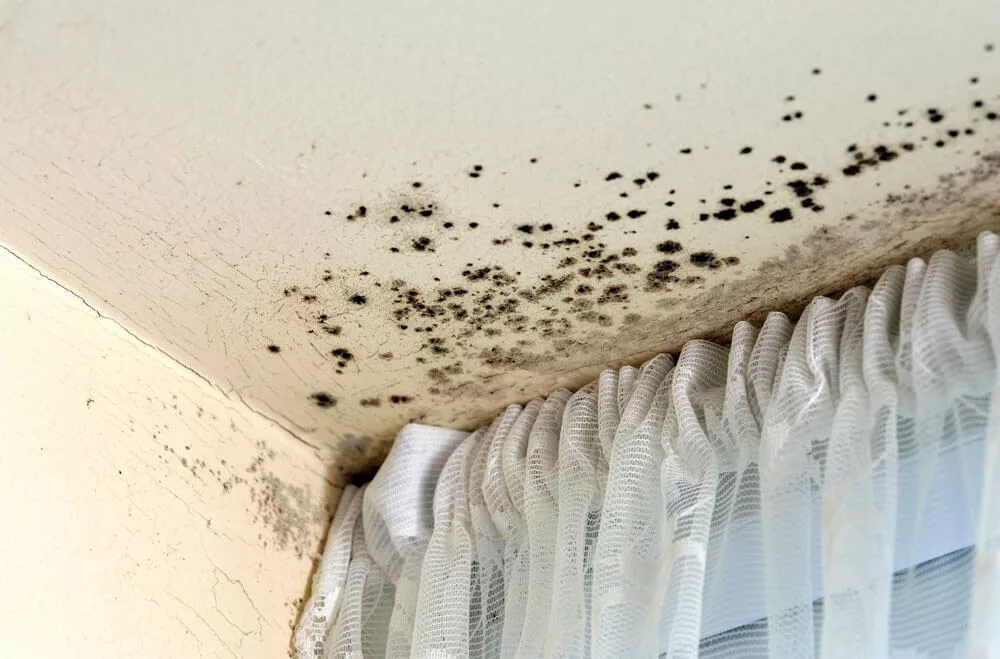Key Takeaways
Effects of Sleeping in a Damp Room – Sleeping in a damp room can lead to improper breathing, rashes, coughing and sneezing, and poor sleep quality. People with existing respiratory and skin conditions can be particularly affected.
Effects of Sleeping in a Room with Mould – Mould, which often accompanies dampness, can lead to a variety of health issues, including headaches, dizziness, lung infections, skin rashes, chest tightness, and a runny nose.
With more and more of us spending our time indoors, living and sleeping in areas affected by dampness and mould has become much more prevalent.
Although many know that damp and mould are bad for our health, less is generally known as to exactly how bad the presence of damp is, especially when paired with its faithful companion, mould.
When it comes to how damp affects our health and quality of sleep, the results of research on the subject have been shocking.
So, let’s take a look at what can we do about dampness, as well as the potential dangers of sleeping in a damp room.
What is damp?
Put simply, damp is the presence of excess moisture within a space.
Physical signs of damp include:
- A distinct musty smell
- Dark patches on walls
- Walls or ceilings that feel wet
- The presence of mould
Excess moisture will either be entering your home through the outside, also known as penetrating or rising damp, or be a result of condensation from inside the home.
In the worst-case scenario, leaks can even undermine the structural integrity of your home.
These structural issues can include electrical shorts, crumbling plaster, wood rot, as well as settling floors.
Reasons for excess moisture:
There are plenty of reasons why you may be experiencing dampness within your property.
While some factors may be resolvable through at-home methods, others may require the intervention of a damp and mould specialist.
Take a look below at a handful of reasons for damp:
- Presence of leaks
Leaks can, unfortunately, happen for a variety of reasons and when they do, they can lead to a host of problems.
Leaks cause excess water to enter your home, resulting in dampness and mould.
If you have noticed an internal leak, then it’s highly recommended that you contact a professional as soon as possible.
Tackling the issue early is the best course of action to prevent costly bills down the line.
- Poor ventilation
Another primary reason why there may be excessive moisture in the home is poor ventilation.
Some rooms may not have windows, making it harder to get adequate airflow to keep moisture at a comfortable level.
- Ineffective heating
Winter is a time in which dampness thrives, for a variety of reasons.
One of these is your home’s general heating system.
Cold outside temperatures coupled with extra moisture in the form of rainfall contrasts with increased indoor heating, resulting in leaks as well as damp.
- Gaps in insulation
Poor insulation goes hand-in-hand with ineffective heating.
As hot indoor air and cold outdoor air meet, condensation is formed which directly leads to damp in the home.
How to remediate damp
Taking a look at the underlying causes of damp we’ve listed above, there are a number of ways in which you can reduce dampness and improve your living conditions.
For ventilation, we recommend opening windows to provide airflow as much as possible.
Where this isn’t possible, for example rooms without windows, two potential ideas include installing an extractor fan to improve airflow, as well as utilising a dehumidifier to bring down humidity levels.
As for heating and insulation, it’s advised that you reduce the amount of moisture produced within the home as much as possible.
Whether that be through water damage clean up, for example fixing internal leaks, or steering clear of drying clothes on the radiator, there are a few ways in which this can be achieved.
Another effective way to remediate damp is through re-plastering and damp proofing. Plastering the interior walls creates a solid surface that resists moisture penetration. Damp proofing involves applying a barrier to walls, floors, or foundations to prevent moisture from seeping in from the ground.
This can be done through a damp proof membrane, or a liquid-applied solution. When combined, plastering and damp proofing provide a comprehensive defence against damp, helping to keep a building dry and protected. These measures, along with improving ventilation, reducing moisture production, and providing proper heating and insulation, can help remediate damp and create a healthier and more comfortable living environment.
We’d recommend finding a fully qualified plasterer & damp proofing expert to complete the job to a high standard.
Effects of sleeping in a damp room
As anyone who has spent time in a damp room knows, it’s not a very pleasant experience.
Potential effects of sleeping in a room with a dampness issue include improper breathing, rashes, coughing and sneezing, as well as poor sleep quality to name a few.
Those with existing respiratory issues, as well as skin conditions, can be particularly affected by the presence of damp.
Numerous studies have shown how damp has exacerbated pre-existing issues, so if you yourself or a family member experiences this, be on the lookout for damp.
If you find yourself struggling with the effects of damp within the home, we recommend contacting a specialist to assess your individual situation.
A thorough check will reveal the underlying cause, allowing you to tackle your issue directly.
Effects of sleeping in a room with mould
Wherever you’ll find damp, chances are that mould won’t be far away.
Much like damp, mould can be devastating to our health, leading to a variety of health issues. These include:
- Headaches
- Dizziness
- Lung infections
- Skin rashes
- Chest tightness
- Runny nose
As well as many more. Children and the elderly, as well as those with compromised immune systems, are particularly at risk from mould.
Prolonged exposure to mould can also lead to respiratory infections, allergic reactions, and asthma.
With a list as extensive as this, it’s never been more important to become aware of the presence of mould and take steps to combat it before it takes root in the home.
What Health Authorities Say About Damp and Mould
The National Health Service (NHS) in the UK provides valuable insights into the health effects of damp and mould. According to the NHS, if your home has damp and mould, you’re more likely to experience respiratory problems, respiratory infections, allergies, and asthma. Damp and mould can also affect the immune system.
Certain individuals are more sensitive to these conditions, including babies and children, older people, those with existing skin problems like atopic eczema, those with respiratory problems like allergies and asthma, and those with a weakened immune system, such as individuals undergoing chemotherapy. These individuals should avoid exposure to damp and mould.
Moulds produce allergens, irritants, and sometimes toxic substances. Inhaling or touching mould spores can cause an allergic reaction, such as sneezing, a runny nose, red eyes, and skin rash. Moulds can also trigger asthma attacks.
Damp and mould are caused by excess moisture, which can be due to a variety of factors, including leaking pipes, rising damp in basements or ground floors, or rain seeping in due to damage to the roof or around window frames. A newly built home may be damp if the water used during construction is still drying out. Excess indoor moisture can also be caused by condensation.
The NHS advises that if you have mould or damp, it’s important to find out why you have excess moisture in your home. Once the cause is identified, you can make necessary repairs or take steps to limit the moisture in the air. In some cases, professional help may be needed to remove mould. There are also home improvement grants and services available which may help with the cost of getting rid of damp and mould.
Comment from Jonathan Haze, Technician at AirFresh Mould Removal London
“As a technician who has been dealing with mould and damp issues for years, I can attest to the severity of the health problems they can cause. This article does an excellent job of highlighting the dangers of sleeping in a damp room and the potential health risks associated with mould exposure.
At AirFresh Mould Removal London, we often encounter clients who are unaware of the extent of these risks. The information from the NHS, as mentioned in this article, is particularly important. It underscores the fact that damp and mould are not just aesthetic or structural issues, but serious health hazards, especially for vulnerable individuals such as babies, the elderly, and those with existing health conditions.
It’s crucial to identify and address the root causes of damp and mould, whether it’s leaking pipes, poor ventilation, or condensation. Professional help is often needed to effectively remove mould and remediate damp conditions. Remember, taking action early can prevent more serious health issues down the line.
I hope this article raises awareness about the importance of maintaining a dry, mould-free living environment. Your health and the health of your loved ones could depend on it.”
Conclusion:
The average adult spends 90% of their time indoors, so it’s never been more important for us to ensure our living environment is safe and comfortable.
The presence of damp and mould is anything but that, so if you’ve noticed some of the signs we’ve mentioned above, it’s certainly worth trying a few remedies to help your situation.
If you find that doing so is still not alleviating your issues, then it’s time to arrange a professional damp and mould removal service.
Doing so will quickly highlight the heart of the issue, and you’ll be on your way to enjoying a happier and healthier home.




